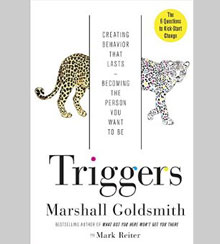Are Marshall Goldsmith’s Triggers the Only Way to Change?
The world’s most eminent executive coach demonstrates the high level of discipline needed for sustainable leadership development.
Triggers: Creating Behavior That Lasts, Becoming the Person You Want to Be
by Marshall Goldsmith and Mark Reiter, Crown Business, 2015
The commonly held belief that life gets easier at the top is partly true. The loftier your role in a large enterprise, the more control you have over your day-to-day activities (and the more you are compensated for them). But the challenges also get tougher. For one thing, you’re more visible. Your mistakes, and your ability to recover from them, will be noticed. Also, fewer positions exist at that rarefied level. To advance, you have to either displace someone above you or create an entirely new business. Failure is not an option, unless you can make it seem like success. To manage all this with integrity — that’s a challenge indeed.
There are two ways to proceed. You can practice relentless discipline: curbing every impulse, making every moment count, and preparing diligently for each potential challenge. Or you can approach the world with insouciant savoir-faire, trusting that your charm and resourcefulness will get you through, while making it all look easy.
Six Questions to Increase Employee Engagement
Leadership author and executive coach Marshall Goldsmith — who is always skeptical of catchphrases like employee engagement — talks about the qualities necessary to galvanize individuals’ commitment at work.
Marshall Goldsmith has a genius for both approaches — in his coaching, his writing about leadership, and his own life. This makes him an invaluable guide for leaders who want, or need, to improve their impact. On the insouciant side, he is a clever, cheerful, and highly experienced bon vivant. If the phrase “life is good” is ever placed in a dictionary, Goldsmith’s picture should be next to it. And yet he is also the most disciplined person you are ever likely to learn about. Indeed, his latest book, Triggers: Creating Behavior That Lasts, Becoming the Person You Want to Be (Crown Business, 2015), coauthored with Mark Reiter, is a guide to the use of discipline as a simultaneous source of self-control and joy.
Every night, Goldsmith forces himself to do one of the most difficult things imaginable. He has a friend call him and ask the same 22 questions. (Remarkably, they are still friends.) These questions all start with the phrase, “Did I do my best [today] to,” and the endings may be strategic (“Did I do my best to set clear goals?”), professional (“…preserve all client relationships?”), philosophical (“…be grateful for what I have?”), physical (“…exercise?”), or personal (“Did I do my best to say or do something nice for Lyda?” [his spouse]). Many of them are directly related to increasing his own leadership skill: “Did I do my best to learn something new? To avoid destructive comments about others?”
Every night, Marshall Goldsmith has a friend call him and ask the same 22 questions.
He has done this for years, revising the questions as his priorities evolve. It’s noteworthy that he doesn’t just answer; he rates his efforts that day for each question on a scale of one to 10. If he’s honest with himself, and there is every reason to believe he is, then this is, in effect, a neo-Calvinist 21st-century form of mental self-flagellation. Except the desired result is not election to heaven, but success here on earth.
These questions are one example of what Goldsmith calls “triggers,” or deliberately designed environmental cues that move you continuously, relentlessly, in the direction of productive, beneficial change. This book explains how to construct and set these triggers for yourself, and use them to help you overcome your own self-indulgence. The triggers are not unlike the “nudges” that Cass Sunstein, a law professor, regulator, and author, proposes the government build into, say, tax structures and healthcare laws, so that people are automatically drawn to lead more self-regulating lives. (For this reason, conservative firebrand Glenn Beck has called Sunstein the “most dangerous man in America.”)
But Goldsmith’s triggers are more soulful than the Sunstein nudges, because they’re all self-chosen. “My mission is to help people become the person that they want to be,” writes Goldsmith, “not tell them who that person is.” Although I appreciate the triggers’ humanism, and the intelligence in their design, I still find myself recoiling from the prospect of adopting them myself. I personally prefer a soupçon of self-indulgence with my savior-faire. I don’t want that level of self-discipline. I just want the results.
But I take Goldsmith at his word when he says that this is the only way to get those results, or to generate serious change. And I buy his unspoken, but all too real, implication: If you don’t put yourself through a regimen of self-scrutiny, if you don’t force yourself to assess how well you followed through on your promises, then you probably don’t deserve to be a CEO.
At the heart of this book is a question about the proper way to live. To what extent must we lead disciplined lives to be powerful people? Is that discipline a matter of duty, compensating for the original sin of being imperfect, or is it a matter of joy, of calling forth the inner golden virtue that lies deep within all of us? In Goldsmith’s eyes, it is both — and if you dare to take on the practices he recommends, you may come to agree with him. ![]()




